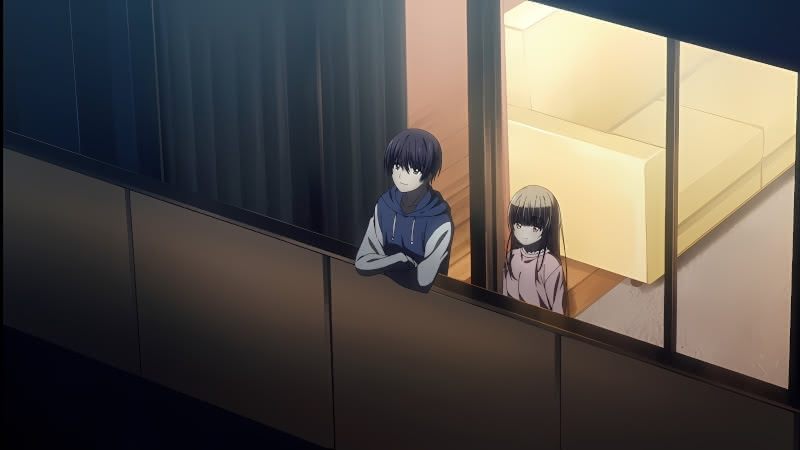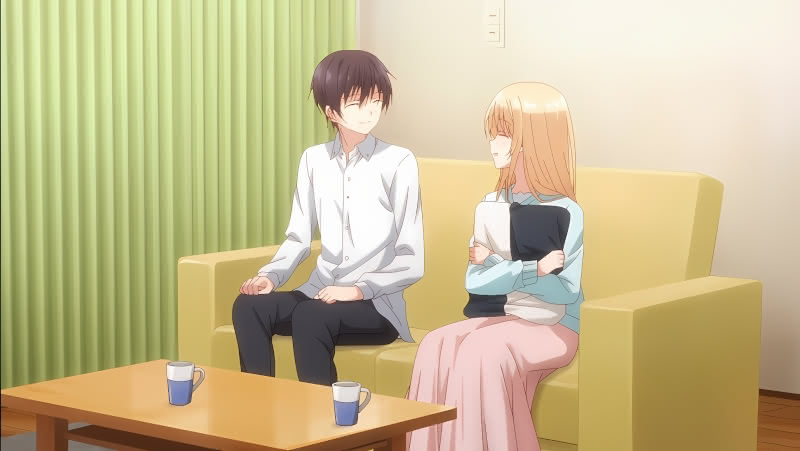I am catching up on several ongoing anime series airing for the 2023 season. While I am behind on a few that I plan to try, I am up to date on the long-titled The Angel Next Door Spoils Me Rotten through five episodes. When I first heard the ending theme song of the series, I experienced a bit of deja vu. I knew I had heard the song before, but I could not remember where I had heard of it. Join me as I retrace how I found the answer to the mystery.
(March 31, 2023 Update: After finishing the series more than a month after writing this article, I published a comprehensive end-series review of The Angel Next Door Spoils Me Rotten. The review is written both for people who have not seen the series yet and those who, liked me, watched all twelve episodes. Other than adding three notes about my full review, this article remains unchanged from its original publication, including my brief thoughts on the series through five episodes.)
The series
I have previously made light of the fact that Japanese lite novels and anime series that follow from them often have excessively long titles. One glance at the translated title The Angel Next Door Spoils Me Rotten betrays its lite novel source material. In light of the fact that the romanticized Japanese title is Otonari no Tenshi-sama ni Itsu no Ma ni ka Dame Ningen ni Saretieta Ken, it seems possible that the English version is actually the short version.
The series features a high school boy (Amane Fujimiya) and girl (Mahiru Shiina) who are in the same class (although not friends), live alone, and happen to live next door to each other. After the boy lends a girl an umbrella in the first episode, she returns the favor when she sees the state of his apartment and learns that he subsists on energy drinks and gels.

No one would accuse Angel Next Door of having a particularly novel set-up, and it is generally true to form. It is the kind of average series that I can tolerate and appreciate if it delivers some good character writing while avoiding devolving into pure wish-fulfillment. Thus far, it has had some good moments and laid the groundwork for some potentially interesting events in its second half. The main characters are well-written enough, but its good moments are off-set by occasional bouts of eye-roll inducing dialogue and the series’ determination to bludgeon us with the fact that everyone in the school admires Mahiru (we get it). My early impression is ‘adequate, but the jury is still out on the final verdict.’
(March 31, 2023 Update: I later published a “final verdict” after finishing the 12-episode series.)
(I am hoping for some explanation of why Mahiru appears to have blonde hair, however. That would make an interesting entry in my run on anime hair color analysis pieces.)
But that is enough about the series. Let us discuss the ending theme song.
The ending theme song
I distinctly remember first noting the ending theme song of The Angel Next Door Spoils Me Rotten at the end of its second episode. I double-checked to confirm that the first episode did not use the ending theme and found that it had instead used what would be the series’ opening theme music along with minimal end credits.
When I heard the series’ ending theme in episode 2, I knew that I had heard the song before, albeit with a different singer. The singer in this case is Ms. Manaka Iwami, the voice of the co-protagonist of the series, Mahiru Shiina.

I rather like the melody, although I cannot understand the lyrics (the song lyrics, unlike the show proper on Crunchyroll, are not subtitled).
That I knew I had heard the song was clear enough to me to leave me with only one question: Where had I heard it?
Finding the name of the song
It is usually easy to find an anime opening or ending on YouTube with a quick search in the form of [anime name] [op or ed], specifying the number for the opening or ending if the series has more than one. I ran a search and quickly locked on to the ending song for The Angel Next Door Spoils Me Rotten: Chiisana Koi no Uta.
Now, before continuing, note that I am not up-to-date on popular trends in J-pop music. In fact, I dare say that few people are as not-up-to-date on all things involving music as I am (unlike my co-writer, professional musician and luthier Victor V. Gurbo). Thus, in the event you are reading this and thinking to yourself that Chiisana Koi no Uta is a popular song, understand that I was not aware of this fact until I conducted a follow-up search.
Learning more about the song
Now armed with the title of the ending song for The Angel Next Door Spoils Me Rotten, I searched for Chiisana Koi no Uta. I came across an article on Crunchyroll, which is airing the series simulcast.
The Crunchyroll article, authored by Ms. Kara Dennison, includes a link to the ending video and song of The Angel Next Door without the anime credits, which you can watch and listen to in the article. But where had I heard it? The beginning of the article did not resolve my question:
The ending theme for this season’s The Angel Next Door Spoils Me Rotten has premiered, and lucky us—Mahiru is singing us a song! But not just any song… one that may be familiar to fans of J-pop, recent anime, and VTubers.
While I am a fan of some recent anime, I know little about J-Pop or VTubers. I needed a more specific hint…
Fortunately, I would be in luck. Ms. Dennison resolved my question in the next full paragraph of the article:
If you feel like you’ve heard the song before… well, you’re almost certainly not wrong! First performed by punk band MONGOL800, ‘Chiisana Koi no Uta’ has become extremely popular. Covers pop up everywhere from YouTube to anime image song albums. Rie Takahashi’s cover of the tune also featured as the fifth ending for KARAKAI JOZU NO TAKAGI-SAN.
Well. That does explain why I remembered it.
For those of you who missed my ranking of the best anime of 2022, I selected the third season of Karakai Jozu No Takagi-san (I used the English title Teasing Master Takagi-san) in my review as my 2022 anime series of the year and opined that the full three-season series was the best anime comedy since 2012’s Humanity Has Declined. However, Chiisana Koi no Uta was used in its first season, which aired all the way back in 2018. While I noted in my 2022 review that the third and final season of Takagi-san far surpassed the first two seasons, I had liked the first season well enough to include it as an honorable mention on my list of recommended anime series for general audiences that aired between 2011 and 2020 (inclusive).
As Ms. Dennison notes, this was the fifth ending song of the 12-episode first season of Takagi-san (I had forgotten how many ending songs the first season used). To be sure, I had liked the song well enough then to remember it when I heard it used in a different show five years later. I was also correct in noting the different singers. In Takagi, the song was performed by the voice actress of Takagi-san, Ms. Rie Takahashi. Thus, we are nothing but consistent in having the voice actress of the main female character sing Chiisana Koi no Uta when it appears in anime series.
Comparing the songs
For those who are curious, both Ms. Iwami’s and Ms. Takahashi’s renditions of Chiisana Koi no Uta are available on official channels on YouTube.
I will link here again to Ms. Iwami’s version for The Angel Next Door Spoils Me Rotten, courtesy of TOHO animation’s YouTube channel (video).
Ms. Takahashi’s rendition for the first season of Teasing Master Takagi-san is available on her official YouTube channel (video). With respect to Ms. Takahashi’s version, note that while the music video is just over four minutes, only the first 90 seconds of the song was used in the anime.
The two versions are quite different, with Ms. Iwami singing in a higher-pitched and, for lack of a better term, younger voice. However, both renditions have their merits. Now forgive me in advance for being a terrible music critic (I do not really have the vocabulary for it), but I appreciated the energy that Ms. Iwami brought to her rendition, especially in the slower early parts of the song before it hits its aesthetic crescendo at around 52 seconds.

Ms. Takanashi’s rendition is significantly less high-pitched than is Ms. Iwami’s, and a bit slower and more subdued too. Despite the deeper sound, I can pick out more of the character Takagi in Ms. Takanashi’s version than I can of Mahiro in Ms. Iwami’s, especially starting at about 50 seconds.
The background music is also notably different in both, although it is the same melody. It is a bit softer in the new version by Ms. Iwami, and I think I am picking up a slight violin or relative thereof. Conversely, Ms. Takanashi is accompanied by a distinct guitar sound that is stronger than any of the background in Ms. Iwami’s, but with less going on beyond the guitar.
While I like both versions, I slightly prefer the Takagi-san version of Chiisana Ko no Uta to the newer Angel Next Door version, but after listening to them a few times while trying to write something semi-intelligent from a music analysis perspective, it ended up being a closer call than I thought it would be going in, owed in large part to the high energy Ms. Iwami brought to her version (certainly a closer call than I think the comparison of the attached series will be). I tip my hat to both Ms. Takanashi and Ms. Iwami for delivering memorable renditions of Chiisana Ko no Uta along with their voicing of the characters Takagi and Mahiru in Takagi-san and Angel Next Door respectively.
March 31, 2023 addition: See my full review of the series.